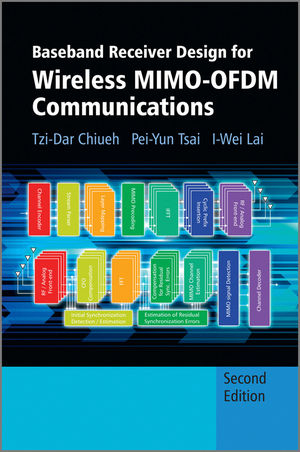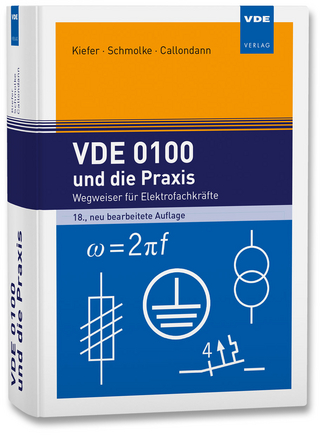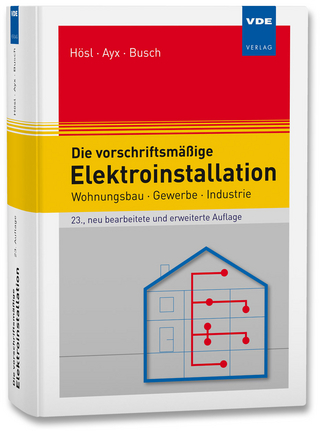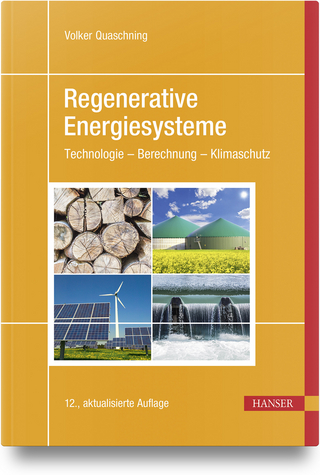
Baseband Receiver Design for Wireless MIMO-OFDM Communications
Wiley-IEEE Press (Verlag)
978-1-118-18818-7 (ISBN)
- Titel z.Zt. nicht lieferbar
- Versandkostenfrei innerhalb Deutschlands
- Auch auf Rechnung
- Verfügbarkeit in der Filiale vor Ort prüfen
- Artikel merken
The book gives a concise yet comprehensive look at digital communication fundamentals before explaining signal processing algorithms in receivers. The authors give detailed treatment of hardware issues - from architecture to IC implementation.
Links OFDM and MIMO theory with hardware implementation
Enables the reader to transfer communication received concepts into hardware; design wireless receivers with acceptable implemntation loss; achieve low-power designs
Covers the latest standards, such as DVB-T2, WiMax, LTE and LTE-A
Includes more baseband algorithms, like soft-decoding algorithms such as BCJR and SOVA
Expanded treatment of channel models, detection algorithms and MIMO techniques
Features concrete design examples of WiMAX systems and cognitive radio apllications
Companion website with lecture slides for instructors
Based on materials developed for a course in digital communication IC design, this book is ideal for graduate students and researchers in VLSI design, wireless communications, and communications signal processing. Practicing engineers working on algorithms or hardware for wireless communications devices will also find this to be a key reference.
Tzi-Dar Chiueh, National Taiwan University, Taiwan Tzi-Dar Chiueh is a Professor of Electrical Engineering at National Taiwan University and Director General of the National Chip Implementation Center in Hsinchu, Taiwan. He has also held visiting positions at ETH Zurich Switzerland at State University of New York at Stony Brook. Chiueh has won numerous awards, including the Acer Long-Term (11 times), the Golden Silicon Award (2002, 2005, 2007, and 2009), NTU Teaching Excellence Award (2002, 2003, 2005, 2006, 2007, and 2010), National Science Council's Outstanding Research Award (2004–2007), Chinese Institute of Electrical Engineers' Outstanding Electrical Engineering Professor, NTU Himax Chair Professorship (2006), and the Ministry of Economic Affairs' Outstanding Industry Contribution Award (2009). He holds a B.S. in Electrical Engineering from National Taiwan University, and an M.S and PhD in Electrical Engineering from the California Institute of Technology. Pei-Yun Tsai, National Central University, Taiwan Pei-Yun Tsai is an Assistant Professor in Electrical Engineering at National Central University. Her research interests are digital baseband communication algorithms, MIMO techniques, and low-power IC/architecture implementation for telecommunications receivers. Tsai has won a number chipset design awards. She holds a B.S, M.S. and PhD in electrical engineering from National Taiwan University. I-Wei Lai, National Taiwan University, Taiwan I-Wei Lai is with the Microsystem Research Lab at National Taiwan University. His research interests include baseband signal processing algorithms and VLSI design.
Preface xiii
About the Authors xvii
Acknowledgements xix
List of Abbreviations and Acronyms xxi
Part One: Fundamentals of Wireless Communication
1. Introduction 3
1.1 Digital Broadcasting Systems 3
1.1.1 Digital Audio Broadcasting (DAB) 4
1.1.2 Digital Video Broadcasting (DVB) 4
1.2 Mobile Cellular Systems 6
1.2.1 Carrier Aggregation 8
1.2.2 Multiple-Antenna Configuration 8
1.2.3 Relay Transmission 9
1.2.4 Coordinated Multipoint Transmission and Reception (CoMP) 9
1.3 Wireless Network Systems 10
1.3.1 Personal Area Network (PAN) 10
1.3.2 Local Area Network (LAN) 12
1.3.3 Metropolitan Area Network (MAN) 13
1.3.4 Wide Area Network (WAN) 14
Summary 14
References 15
2. Digital Modulation 17
2.1 Single-Carrier Modulation 17
2.1.1 Power Spectral Densities of Modulation Signals 18
2.1.2 PSK, QAM, and ASK 19
2.1.3 CPFSK and MSK 22
2.1.4 Pulse Shaping and Windowing 23
2.2 Multi-Carrier Modulation 24
2.2.1 Orthogonal Frequency-Division Multiplexing 27
2.2.2 OFDM Related Issues 27
2.2.3 OFDM Transceiver Architecture 31
2.3 Adaptive OFDM 33
Summary 37
References 37
3. Advanced Wireless Technology 39
3.1 Multiple-Input Multiple-Output (MIMO) 39
3.1.1 Introduction 39
3.1.2 MIMO Basics 41
3.1.3 MIMO Techniques 43
3.1.4 MIMO-OFDM System Example 50
3.2 Multiple Access 53
3.2.1 Frequency-Division Multiple Access (FDMA) 54
3.2.2 Time-Division Multiple Access (TDMA) 54
3.2.3 Code-Division Multiple Access (CDMA) 55
3.2.4 Carrier Sense Multiple Access (CSMA) 57
3.2.5 Orthogonal Frequency-Division Multiple Access (OFDMA) 57
3.2.6 Space-Division Multiple Access (SDMA) 58
3.3 Spread Spectrum and CDMA 59
3.3.1 PN Codes 60
3.3.2 Direct-Sequence Spread Spectrum 63
3.3.3 Frequency-Hopping Spread Spectrum 65
Summary 66
References 67
4. Error-Correcting Codes 69
4.1 Introduction 69
4.2 Block Codes 70
4.2.1 Linear Codes 70
4.2.2 Cyclic Codes 72
4.3 Reed–Solomon Codes 73
4.3.1 Finite Fields 74
4.3.2 Encoding 75
4.3.3 Decoding 76
4.3.4 Shortened Reed–Solomon Codes 76
4.4 Convolutional Codes 77
4.4.1 Encoding 77
4.4.2 Viterbi Decoder 79
4.4.3 Punctured Convolutional Codes 80
4.5 Soft-Input Soft-Output Decoding Algorithms 81
4.5.1 MAP Decoder 82
4.5.2 Log-MAP Decoder 85
4.5.3 Max-Log-MAP Decoder 86
4.6 Turbo Codes 87
4.6.1 Encoding 87
4.6.2 Decoding 88
4.7 Low-Density Parity-Check Codes 89
4.7.1 Encoding 89
4.7.2 Decoding 91
Summary 93
References 94
5. Signal Propagation and Channel Model 95
5.1 Introduction 95
5.2 Wireless Channel Propagation 96
5.2.1 Path Loss and Shadowing 96
5.2.2 Multipath Fading 97
5.2.3 Multipath Channel Parameters 98
5.2.4 MIMO Channel 104
5.3 Front-End Electronics Effects 105
5.3.1 Carrier Frequency Offset 105
5.3.2 Sampling Clock Offset 106
5.3.3 Phase Noise 106
5.3.4 IQ Imbalance and DC Offset 107
5.3.5 Power Amplifier Nonlinearity 110
5.4 Channel Model 111
5.4.1 Model for Front-End Impairments 112
5.4.2 Multipath Rayleigh Fader Model 113
5.4.3 Channel Models Used in Standards 116
Summary 122
References 123
Part Two: MIMO-OFDM Receiver Processing
6. Synchronization 127
6.1 Introduction 127
6.2 Synchronization Issues 128
6.2.1 Synchronization Errors 128
6.2.2 Effects of Synchronization Errors 128
6.2.3 Consideration for Estimation and Compensation 133
6.3 Detection and Estimation of Synchronization Errors 134
6.3.1 Symbol Timing Detection 134
6.3.2 Carrier Frequency Offset Estimation 143
6.3.3 Residual CFO and SCO Estimation 147
6.3.4 Carrier Phase Estimation 149
6.3.5 IQ Imbalance Estimation 150
6.4 Detection and Estimation of Synchronization Errors in MIMO-OFDM Systems 153
6.4.1 Symbol Timing Detection in MIMO-OFDM Systems 153
6.4.2 Carrier Frequency Offset Estimation in MIMO-OFDM Systems 155
6.4.3 Residual CFO and SCO Estimation in MIMO-OFDM Systems 156
6.4.4 Carrier Phase Estimation in MIMO-OFDM Systems 157
6.4.5 IQ Imbalance Estimation in MIMO-OFDM Systems 157
6.5 Recovery of Synchronization Errors 158
6.5.1 Carrier Frequency Offset Compensation 158
6.5.2 Sampling Clock Offset and Common Phase Error Compensation 160
6.5.3 IQ Imbalance Compensation 163
Summary 163
References 164
7. Channel Estimation and Equalization 167
7.1 Introduction 167
7.2 Pilot Pattern 168
7.2.1 Pilot Pattern in SISO-OFDM Systems 168
7.2.2 Pilot Pattern in MIMO-OFDM Systems 171
7.3 SISO-OFDM Channel Estimation 174
7.3.1 Channel Estimation by Block-Type Pilot Symbols 177
7.3.2 Channel Estimation by Comb-Type Pilot Symbols 179
7.3.3 Channel Estimation by Grid-Type Pilot Symbols 186
7.4 MIMO-OFDM Channel Estimation 191
7.4.1 Space–Time Pilot 191
7.5 Adaptive Channel Estimation 194
7.6 Equalization 195
7.6.1 One-Tap Equalizer 195
7.6.2 Multi-Tap Equalizer 198
7.7 Iterative Receiver 204
7.7.1 Iterative Synchronization and Channel Estimation 205
7.7.2 Bit-Interleaved Coded Modulation with Iterative Decoding (BICM-ID) 205
Summary 206
References 207
8. MIMO Detection 209
8.1 Introduction 209
8.2 Linear Detection 210
8.2.1 Zero Forcing (ZF) 210
8.2.2 Minimum Mean Squared Error (MMSE) 211
8.3 MIMO Detection with Channel Preprocessing 212
8.3.1 Sorting 212
8.3.2 QR Decomposition 213
8.3.3 MMSE-SQRD 215
8.3.4 Ordered Successive Interference Cancelation (OSIC) 216
8.3.5 Lattice Reduction (LR) 218
8.4 Sphere Decoder 220
8.4.1 Depth-First Tree Search 221
8.4.2 Breadth-First Tree Search 223
8.4.3 Best-First Tree Search 224
8.4.4 Complexity Measurement 227
8.4.5 Design Space Exploration of Sphere Decoder 227
8.5 Soft-Output Sphere Decoder 230
8.5.1 Repeated Tree Search 231
8.5.2 Single Tree Search 232
8.5.3 LLR Clipping 232
8.6 Iterative MIMO Detection 234
8.6.1 List Sphere Decoder 234
8.6.2 Soft-Input Soft-Output Sphere Decoder 235
8.6.3 Iterative SIC-MMSE Detection 237
8.7 Precoding 239
8.7.1 Beam Steering 239
8.7.2 Spatial Decorrelation 241
8.7.3 Limited Feedback 244
8.8 Space Block Code 246
Summary 247
References 248
Part Three: Hardware Design for MIMO-OFDM Receivers
9. Circuit Techniques 253
9.1 Introduction 253
9.2 Fast Fourier Transform Modules 253
9.2.1 FFT Algorithms 254
9.2.2 Architecture 259
9.2.3 Comparison 264
9.3 Delay Buffer 267
9.3.1 SRAM/Register File-Based Delay Buffer 267
9.3.2 Pointer-Based Delay Buffer 268
9.3.3 Gated Clock Strategy 269
9.3.4 Comparison 272
9.4 Circuits for Rectangular-to-Polar Conversion 274
9.4.1 Arctangent Function 274
9.4.2 Magnitude Function 279
9.4.3 Comparison 286
9.5 Circuits for Polar-to-Rectangular Conversion 286
9.5.1 Trigonometric Approximation 287
9.5.2 Polynomial Approximation 288
9.5.3 Comparison 290
Summary 290
References 291
10. MIMO IC Design Examples 293
10.1 Introduction 293
10.2 QR Decomposition IC 294
10.2.1 System Description 294
10.2.2 Algorithm Design 295
10.2.3 Architecture Design 300
10.2.4 Experimental Results 303
10.3 8 × 8 Soft-Output Sphere Decoder 306
10.3.1 Block Description 306
10.3.2 Algorithm Design 306
10.3.3 Architecture Design 307
10.3.4 Experimental Results 316
Summary 318
References 319
11. Mobile MIMO WiMAX System-on-Chip Design 321
11.1 Introduction of WiMAX Standard 321
11.2 Mobile WiMAX OFDMA and Frame Structure 322
11.3 WiMAX Baseband Receiver Design 325
11.3.1 Automatic Gain Control (AGC) 325
11.3.2 Packet Detection (PKD) 326
11.3.3 Symbol Timing Recovery (STR) 328
11.3.4 Carrier Frequency Offset (CFO) Compensation 328
11.3.5 Channel Estimation 330
11.3.6 MIMO Detection 330
11.3.7 Outer Receiver 333
11.4 WiMAX Media Access Control (MAC) Design 333
11.5 Implementation and Field Trial of the WiMAX SoC 336
11.5.1 Laboratory Testing and Performance Evaluation 338
11.5.2 Taiwan High Speed Rail Field Trial 340
Summary 341
References 341
Index 343
| Reihe/Serie | IEEE Press |
|---|---|
| Sprache | englisch |
| Maße | 173 x 252 mm |
| Gewicht | 726 g |
| Themenwelt | Sachbuch/Ratgeber |
| Technik ► Elektrotechnik / Energietechnik | |
| Technik ► Nachrichtentechnik | |
| ISBN-10 | 1-118-18818-7 / 1118188187 |
| ISBN-13 | 978-1-118-18818-7 / 9781118188187 |
| Zustand | Neuware |
| Informationen gemäß Produktsicherheitsverordnung (GPSR) | |
| Haben Sie eine Frage zum Produkt? |
aus dem Bereich


